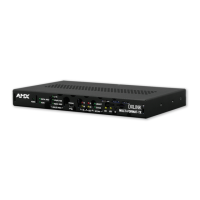
Do you have a question about the AMX DXLink and is the answer not in the manual?
| Category | Receiver |
|---|---|
| Dimensions | Varies by model |
| Weight | Varies by model |
| HDCP Compliance | Yes |
| Video Input Signal | HDMI |
| Control | RS-232, IR, Ethernet |
| Input Connector | HDMI |
| Output Connector | HDMI |
| Operating Temperature | 0° to 50° C |
| Humidity | 10% to 90% non-condensing |
| Storage Temperature | -20° to 70° C |
Guidance on preventing damage from electrostatic discharge to sensitive components.
Essential safety precautions for installing and operating AMX products.
Detailed specifications for HDMI video signal types, resolutions, and formats.
Specifications for analog video inputs on Multi-Format TX, Wallplate TX, and Decor Wallplate TX.
Specifications for local audio inputs and outputs for TX and RX modules.
Key considerations for powering DXLink modules with Enova DGX systems.
Instructions for applying power to Multi-Format TX and HDMI TX modules.
Instructions for applying power to the HDMI RX module.
Procedure to reset a Transmitter or Receiver to its factory default settings.
List and syntax for video SEND_COMMANDs for DXLink receivers.
List and syntax for audio SEND_COMMANDs for DXLink receivers.
List and syntax for video SEND_COMMANDs for DXLink transmitters.
List and syntax for audio SEND_COMMANDs for DXLink transmitters.
General steps for diagnosing and resolving basic DXLink issues.
Troubleshooting steps for power-related problems with DXLink devices.
Methods for diagnosing and resolving DXLink connection problems.
Steps to prepare an endpoint system for KIT file transfer.
Steps to prepare an extender system for KIT file transfer.
Crucial information and cautions regarding firmware upgrade procedures.
Detailed instructions for transferring KIT files to DXLink devices.
List of commands that can be sent directly to DXLink devices via Telnet.
Steps to configure the PC with a static IP address for Virtual Master setup.
Instructions for creating a Virtual Master within NetLinx Studio.
Steps to configure DXLink modules for connection with a Virtual Master.
